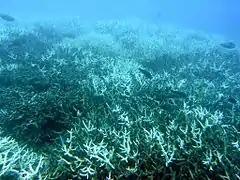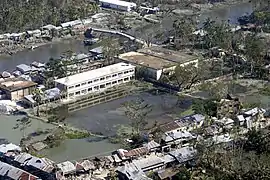Carbon dioxide in Earth's atmosphere
In Earth's atmosphere, carbon dioxide is a trace gas that plays an integral part in the greenhouse effect, carbon cycle, photosynthesis and oceanic carbon cycle. It is one of several greenhouse gases in the atmosphere of Earth. The current global average concentration of CO2 in the atmosphere is 421 ppm as of May 2022 (0.04%).[3] This is an increase of 50% since the start of the Industrial Revolution, up from 280 ppm during the 10,000 years prior to the mid-18th century.[4][3][5] The increase is due to human activity.[6] Burning fossil fuels is the main cause of these increased CO2 concentrations and also the main cause of climate change.[7] Other large anthropogenic sources include cement production, deforestation, and biomass burning.

While transparent to visible light, carbon dioxide is a greenhouse gas, absorbing and emitting infrared radiation at its two infrared-active vibrational frequencies. CO2 absorbs and emits infrared radiation at wavelengths of 4.26 μm (2,347 cm−1) (asymmetric stretching vibrational mode) and 14.99 μm (667 cm−1) (bending vibrational mode). It plays a significant role in influencing Earth's surface temperature through the greenhouse effect.[8] Light emission from the Earth's surface is most intense in the infrared region between 200 and 2500 cm−1,[9] as opposed to light emission from the much hotter Sun which is most intense in the visible region. Absorption of infrared light at the vibrational frequencies of atmospheric CO2 traps energy near the surface, warming the surface and the lower atmosphere. Less energy reaches the upper atmosphere, which is therefore cooler because of this absorption.[10]
Increases in atmospheric concentrations of CO2 and other long-lived greenhouse gases such as methane, nitrous oxide and ozone increase the absorption and emission of infrared radiation by the atmosphere, causing the observed rise in average global temperature and ocean acidification. Another direct effect is the CO2 fertilization effect. These changes cause a range of indirect effects of climate change on the physical environment, ecosystems and human societies. Carbon dioxide exerts a larger overall warming influence than all of the other greenhouse gases combined.[5] It has an atmospheric lifetime that increases with the cumulative amount of fossil carbon extracted and burned, due to the imbalance that this activity has imposed on Earth's fast carbon cycle.[11] This means that some fraction (a projected 20–35%) of the fossil carbon transferred thus far will persist in the atmosphere as elevated CO2 levels for many thousands of years after these carbon transfer activities begin to subside.[12][13][14] The carbon cycle is a biogeochemical cycle in which carbon is exchanged between the Earth's oceans, soil, rocks and the biosphere. Plants and other photoautotrophs use solar energy to produce carbohydrate from atmospheric carbon dioxide and water by photosynthesis. Almost all other organisms depend on carbohydrate derived from photosynthesis as their primary source of energy and carbon compounds.
The present atmospheric concentration of CO2 is the highest for 14 million years.[15] Concentrations of CO2 in the atmosphere were as high as 4,000 ppm during the Cambrian period about 500 million years ago, and as low as 180 ppm during the Quaternary glaciation of the last two million years.[4] Reconstructed temperature records for the last 420 million years indicate that atmospheric CO2 concentrations peaked at approximately 2,000 ppm during the Devonian (400 Ma) period, and again in the Triassic (220–200 Ma) period and was four times current levels during the Jurassic period (201–145 Ma).[16][17]
Current concentration and future trends
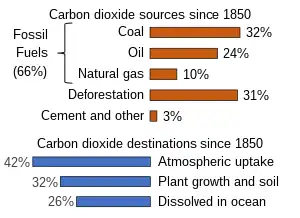
Current situation
Since the start of the Industrial Revolution, atmospheric CO2 concentration have been increasing, causing global warming and ocean acidification.[18] As of May 2022, the average monthly level of CO2 in Earth's atmosphere reached 421 parts per million by volume (ppm).[3] "Parts per million" refers to the number of carbon dioxide molecules per million molecules of dry air.[19] Previously, the value was 280 ppm during the 10,000 years up to the mid-18th century.[4][3][5]
Each part per million of CO2 in the atmosphere represents approximately 2.13 gigatonnes of carbon, or 7.82 gigatonnes of CO2.[20]
It was pointed out in 2021 that "the current rates of increase of the concentration of the major greenhouse gases (carbon dioxide, methane and nitrous oxide) are unprecedented over at least the last 800,000 years".[21]: 515
Annual and regional fluctuations
Atmospheric CO2 concentrations fluctuate slightly with the seasons, falling during the Northern Hemisphere spring and summer as plants consume the gas and rising during northern autumn and winter as plants go dormant or die and decay. The level drops by about 6 or 7 ppm (about 50 Gt) from May to September during the Northern Hemisphere's growing season, and then goes up by about 8 or 9 ppm. The Northern Hemisphere dominates the annual cycle of CO2 concentration because it has much greater land area and plant biomass than the Southern Hemisphere. Concentrations reach a peak in May as the Northern Hemisphere spring greenup begins, and decline to a minimum in October, near the end of the growing season.[22][23]
Concentrations also vary on a regional basis, most strongly near the ground with much smaller variations aloft. In urban areas concentrations are generally higher[24] and indoors they can reach 10 times background levels.
Measurements and predictions made in the recent past
- Estimates in 2001 found that the current carbon dioxide concentration in the atmosphere may be the highest in the last 20 million years.[25] This figure has been corrected down since then, whereby the latest estimate is now 14 million years (estimate from 2013).[15] Most recently, IPCC AR6 (see for example figure 2.34) reports similar levels 3-3.3 mya in the mid-Pliocene warm period. AR6 reports this period as a good proxy for likely climate outcomes with current levels of CO2.
- Data from 2009 found that the global mean CO2 concentration was rising at a rate of approximately 2 ppm/year and accelerating.[26][27]
- The daily average concentration of atmospheric CO2 at Mauna Loa Observatory first exceeded 400 ppm on 10 May 2013[28][29] although this concentration had already been reached in the Arctic in June 2012.[30] Data from 2013 showed that the concentration of carbon dioxide in the atmosphere is this high "for the first time in 55 years of measurement—and probably more than 3 million years of Earth history."[31]
- As of 2018, CO2 concentrations were measured to be 410 ppm.[26][32]
Measurement techniques

The concentrations of carbon dioxide in the atmosphere are expressed as parts per million by volume (abbreviated as ppmv or just ppm). To convert from the usual ppmv units to ppm mass, multiply by the ratio of the molar weight of CO2 to that of air, i.e. times 1.52 (44.01 divided by 28.96).
The first reproducibly accurate measurements of atmospheric CO2 were from flask sample measurements made by Dave Keeling at Caltech in the 1950s.[33] Measurements at Mauna Loa have been ongoing since 1958. Additionally, measurements are also made at many other sites around the world. Many measurement sites are part of larger global networks. Global network data are often made publicly available.
Data networks
There are several surface measurement (including flasks and continuous in situ) networks including NOAA/ERSL,[34] WDCGG,[35] and RAMCES.[36] The NOAA/ESRL Baseline Observatory Network, and the Scripps Institution of Oceanography Network[37] data are hosted at the CDIAC at ORNL. The World Data Centre for Greenhouse Gases (WDCGG), part of GAW, data are hosted by the JMA. The Reseau Atmospherique de Mesure des Composes an Effet de Serre database (RAMCES) is part of IPSL.
From these measurements, further products are made which integrate data from the various sources. These products also address issues such as data discontinuity and sparseness. GLOBALVIEW-CO2 is one of these products.[38]
Ongoing ground-based total column measurements began more recently. Column measurements typically refer to an averaged column amount denoted XCO2, rather than a surface only measurement. These measurements are made by the TCCON. These data are also hosted on the CDIAC, and made publicly available according to the data use policy.[39]
Satellite measurements
Space-based measurements of carbon dioxide are also a recent addition to atmospheric XCO2 measurements. SCIAMACHY aboard ESA's ENVISAT made global column XCO2 measurements from 2002 to 2012. AIRS aboard NASA's Aqua satellite makes global XCO2 measurements and was launched shortly after ENVISAT in 2012. More recent satellites have significantly improved the data density and precision of global measurements. Newer missions have higher spectral and spatial resolutions. JAXA's GOSAT was the first dedicated GHG monitoring satellite to successfully achieve orbit in 2009. NASA's OCO-2 launched in 2014 was the second. Various other satellites missions to measure atmospheric XCO2 are planned.
Analytical methods to investigate sources of CO2
- The burning of long-buried fossil fuels releases CO2 containing carbon of different isotopic ratios to those of living plants, enabling distinction between natural and human-caused contributions to CO2 concentration.[40]
- There are higher atmospheric CO2 concentrations in the Northern Hemisphere, where most of the world's population lives (and emissions originate from), compared to the southern hemisphere. This difference has increased as anthropogenic emissions have increased.[41]
- Atmospheric O2 levels are decreasing in Earth's atmosphere as it reacts with the carbon in fossil fuels to form CO2.[42]
Causes of the current increase
Anthropogenic CO2 emissions

While CO2 absorption and release is always happening as a result of natural processes, the recent rise in CO2 levels in the atmosphere is known to be mainly due to human (anthropogenic) activity.[21] Anthropogenic carbon emissions exceed the amount that can be taken up or balanced out by natural sinks.[44] Thus carbon dioxide has gradually accumulated in the atmosphere and, as of May 2022, its concentration is 50% above pre-industrial levels.[3]
The extraction and burning of fossil fuels, releasing carbon that has been underground for many millions of years, has increased the atmospheric concentration of CO2.[5][18] As of year 2019 the extraction and burning of geologic fossil carbon by humans releases over 30 gigatonnes of CO2 (9 billion tonnes carbon) each year.[45] This larger disruption to the natural balance is responsible for recent growth in the atmospheric CO2 concentration.[32][46] Currently about half of the carbon dioxide released from the burning of fossil fuels is not absorbed by vegetation and the oceans and remains in the atmosphere.[47]
Burning fossil fuels such as coal, petroleum, and natural gas is the leading cause of increased anthropogenic CO2; deforestation is the second major cause. In 2010, 9.14 gigatonnes of carbon (GtC, equivalent to 33.5 gigatonnes of CO2 or about 4.3 ppm in Earth's atmosphere) were released from fossil fuels and cement production worldwide, compared to 6.15 GtC in 1990.[48] In addition, land use change contributed 0.87 GtC in 2010, compared to 1.45 GtC in 1990.[48] In the period 1751 to 1900, about 12 GtC were released as CO2 to the atmosphere from burning of fossil fuels, whereas from 1901 to 2013 the figure was about 380 GtC.[49]
The International Energy Agency estimates that the top 1% of emitters globally each had carbon footprints of over 50 tonnes of CO2 in 2021, more than 1,000 times greater than those of the bottom 1% of emitters. The global average energy-related carbon footprint is around 4.7 tonnes of CO2 per person.[50]
Roles in natural processes on Earth
Greenhouse effect
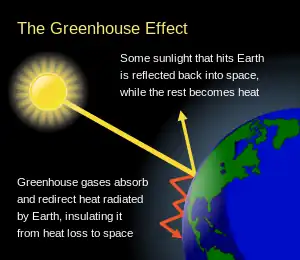
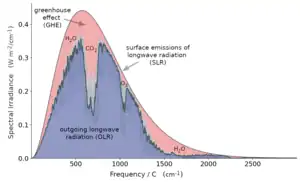

Earth's natural greenhouse effect makes life as we know it possible and carbon dioxide plays a significant role in providing for the relatively high temperature on Earth. The greenhouse effect is a process by which thermal radiation from a planetary atmosphere warms the planet's surface beyond the temperature it would have in the absence of its atmosphere.[51][52][53] Without the greenhouse effect, the Earth's average surface temperature would be about −18 °C (−0.4 °F)[54][55] compared to Earth's actual average surface temperature of approximately 14 °C (57.2 °F).[56]
Water is responsible for most (about 36–70%) of the total greenhouse effect, and the role of water vapor as a greenhouse gas depends on temperature. On Earth, carbon dioxide is the most relevant, direct anthropologically influenced greenhouse gas. Carbon dioxide is often mentioned in the context of its increased influence as a greenhouse gas since the pre-industrial (1750) era. In 2013, the increase in CO2 was estimated to be responsible for 1.82 W m−2 of the 2.63 W m−2 change in radiative forcing on Earth (about 70%).[57]
The concept of atmospheric CO2 increasing ground temperature was first published by Svante Arrhenius in 1896.[58] The increased radiative forcing due to increased CO2 in the Earth's atmosphere is based on the physical properties of CO2 and the non-saturated absorption windows where CO2 absorbs outgoing long-wave energy. The increased forcing drives further changes in Earth's energy balance and, over the longer term, in Earth's climate.[21]
| Part of a series on the |
| Carbon cycle |
|---|
 |
|
Carbon cycle

Atmospheric carbon dioxide plays an integral role in the Earth's carbon cycle whereby CO2 is removed from the atmosphere by some natural processes such as photosynthesis and deposition of carbonates, to form limestones for example, and added back to the atmosphere by other natural processes such as respiration and the acid dissolution of carbonate deposits. There are two broad carbon cycles on Earth: the fast carbon cycle and the slow carbon cycle. The fast carbon cycle refers to movements of carbon between the environment and living things in the biosphere whereas the slow carbon cycle involves the movement of carbon between the atmosphere, oceans, soil, rocks, and volcanism. Both cycles are intrinsically interconnected and atmospheric CO2 facilitates the linkage.
Natural sources of atmospheric CO2 include volcanic outgassing, the combustion of organic matter, wildfires and the respiration processes of living aerobic organisms. Man-made sources of CO2 include the burning of fossil fuels for heating, power generation and transport, as well as some industrial processes such as cement making. It is also produced by various microorganisms from fermentation and cellular respiration. Plants, algae and cyanobacteria convert carbon dioxide to carbohydrates by a process called photosynthesis. They gain the energy needed for this reaction from absorption of sunlight by chlorophyll and other pigments. Oxygen, produced as a by-product of photosynthesis, is released into the atmosphere and subsequently used for respiration by heterotrophic organisms and other plants, forming a cycle with carbon.
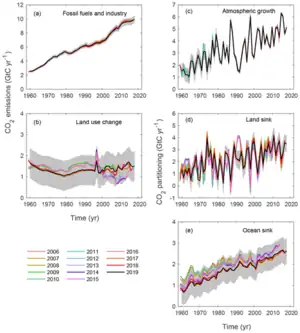
Most sources of CO2 emissions are natural, and are balanced to various degrees by similar CO2 sinks. For example, the decay of organic material in forests, grasslands, and other land vegetation - including forest fires - results in the release of about 436 gigatonnes of CO2 (containing 119 gigatonnes carbon) every year, while CO2 uptake by new growth on land counteracts these releases, absorbing 451 Gt (123 Gt C).[60] Although much CO2 in the early atmosphere of the young Earth was produced by volcanic activity, modern volcanic activity releases only 130 to 230 megatonnes of CO2 each year.[61] Natural sources are more or less balanced by natural sinks, in the form of chemical and biological processes which remove CO2 from the atmosphere.
Overall, there is a large natural flux of atmospheric CO2 into and out of the biosphere, both on land and in the oceans.[62] In the pre-industrial era, each of these fluxes were in balance to such a degree that little net CO2 flowed between the land and ocean reservoirs of carbon, and little change resulted in the atmospheric concentration. From the human pre-industrial era to 1940, the terrestrial biosphere represented a net source of atmospheric CO2 (driven largely by land-use changes), but subsequently switched to a net sink with growing fossil carbon emissions.[63] In 2012, about 57% of human-emitted CO2, mostly from the burning of fossil carbon, was taken up by land and ocean sinks.[64][63]
The ratio of the increase in atmospheric CO2 to emitted CO2 is known as the airborne fraction. This ratio varies in the short-term and is typically about 45% over longer (5-year) periods.[63] Estimated carbon in global terrestrial vegetation increased from approximately 740 gigatonnes in 1910 to 780 gigatonnes in 1990.[65]
Photosynthesis

Carbon dioxide in the Earth's atmosphere is essential to life and to most of the planetary biosphere. The average rate of energy capture by photosynthesis globally is approximately 130 terawatts,[66][67][68] which is about six times larger than the current power consumption of human civilization.[69] Photosynthetic organisms also convert around 100–115 billion metric tonnes of carbon into biomass per year.[70][71]
Photosynthetic organisms are photoautotrophs, which means that they are able to synthesize food directly from CO2 and water using energy from light. However, not all organisms that use light as a source of energy carry out photosynthesis, since photoheterotrophs use organic compounds, rather than CO2, as a source of carbon.[72] In plants, algae and cyanobacteria, photosynthesis releases oxygen. This is called oxygenic photosynthesis. Although there are some differences between oxygenic photosynthesis in plants, algae, and cyanobacteria, the overall process is quite similar in these organisms. Some types of bacteria, however, carry out anoxygenic photosynthesis, which consumes CO2 but does not release oxygen.
Carbon dioxide is converted into sugars in a process called carbon fixation. Carbon fixation is an endothermic redox reaction, so photosynthesis needs to supply both the source of energy to drive this process and the electrons needed to convert CO2 into a carbohydrate. This addition of the electrons is a reduction reaction. In general outline and in effect, photosynthesis is the opposite of cellular respiration, in which glucose and other compounds are oxidized to produce CO2 and water, and to release exothermic chemical energy to drive the organism's metabolism. The two processes take place through a different sequence of chemical reactions, however, and in different cellular compartments.
Oceanic carbon cycle

The Earth's oceans contain a large amount of CO2 in the form of bicarbonate and carbonate ions—much more than the amount in the atmosphere. The bicarbonate is produced in reactions between rock, water, and carbon dioxide. One example is the dissolution of calcium carbonate:
- CaCO
3 + CO2 + H
2O ⇌ Ca2+
+ 2 HCO−
3
Reactions like this tend to buffer changes in atmospheric CO2. Since the right side of the reaction produces an acidic compound, adding CO2 on the left side decreases the pH of seawater, a process which has been termed ocean acidification (pH of the ocean becomes more acidic although the pH value remains in the alkaline range). Reactions between CO2 and non-carbonate rocks also add bicarbonate to the seas. This can later undergo the reverse of the above reaction to form carbonate rocks, releasing half of the bicarbonate as CO2. Over hundreds of millions of years, this has produced huge quantities of carbonate rocks.
From 1850 until 2022, the ocean has absorbed 26% of total anthropogenic emissions.[18] However, the rate at which the ocean will take it up in the future is less certain. Even if equilibrium is reached, including dissolution of carbonate minerals, the increased concentration of bicarbonate and decreased or unchanged concentration of carbonate ion will give rise to a higher concentration of un-ionized carbonic acid and dissolved CO2. This higher concentration in the seas, along with higher temperatures, would mean a higher equilibrium concentration of CO2 in the air.[73][74]
Carbon moves between the atmosphere, vegetation (dead and alive), the soil, the surface layer of the ocean, and the deep ocean.
Effects of current increase
Direct effects
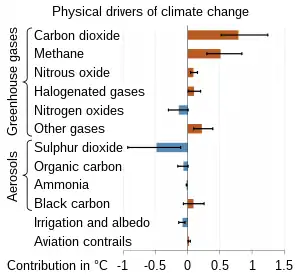
Direct effects of increasing CO2 concentrations in the atmosphere include increasing global temperatures, ocean acidification and a CO2 fertilization effect on plants and crops.[75]
Temperature rise on land
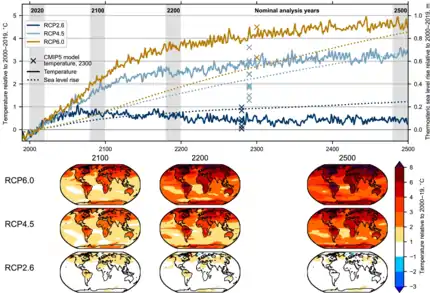
The global average and combined land and ocean surface temperature, show a warming of 1.09 °C (range: 0.95 to 1.20 °C) from 1850–1900 to 2011–2020, based on multiple independently produced datasets.[78]: 5 The trend is faster since 1970s than in any other 50-year period over at least the last 2000 years.[78]: 8
Most of the observed warming occurred in two periods: around 1900 to around 1940 and around 1970 onwards;[79] the cooling/plateau from 1940 to 1970 has been mostly attributed to sulphate aerosol.[80][81]: 207 Some of the temperature variations over this time period may also be due to ocean circulation patterns.[82]Temperature rise in oceans
It is clear that the ocean is warming as a result of climate change, and this rate of warming is increasing.[83]: 9 The global ocean was the warmest it had ever been recorded by humans in 2022.[84] This is determined by the ocean heat content, which exceeded the previous 2021 maximum in 2022.[84] The steady rise in ocean temperatures is an unavoidable result of the Earth's energy imbalance, which is primarily caused by rising levels of greenhouse gases.[84] Between pre-industrial times and the 2011–2020 decade, the ocean's surface has heated between 0.68 and 1.01 °C.[85]: 1214
The upper ocean (above 700 m) is warming the fastest, but the warming trend is widespread. The majority of ocean heat gain occurs in the Southern Ocean. For example, between the 1950s and the 1980s, the temperature of the Antarctic Southern Ocean rose by 0.17 °C (0.31 °F), nearly twice the rate of the global ocean.[86]Ocean acidification
Ocean acidification is the decrease in the pH of the Earth's ocean. Between 1950 and 2020, the average pH of the ocean surface fell from approximately 8.15 to 8.05.[87] Carbon dioxide emissions from human activities are the primary cause of ocean acidification, with atmospheric carbon dioxide (CO2) levels exceeding 410 ppm (in 2020). CO2 from the atmosphere is absorbed by the oceans. This produces carbonic acid (H2CO3) which dissociates into a bicarbonate ion (HCO−3) and a hydrogen ion (H+). The presence of free hydrogen ions (H+) lowers the pH of the ocean, increasing acidity (this does not mean that seawater is acidic yet; it is still alkaline, with a pH higher than 8). Marine calcifying organisms, such as mollusks and corals, are especially vulnerable because they rely on calcium carbonate to build shells and skeletons.[88]
A change in pH by 0.1 represents a 26% increase in hydrogen ion concentration in the world's oceans (the pH scale is logarithmic, so a change of one in pH units is equivalent to a tenfold change in hydrogen ion concentration). Sea-surface pH and carbonate saturation states vary depending on ocean depth and location. Colder and higher latitude waters are capable of absorbing more CO2. This can cause acidity to rise, lowering the pH and carbonate saturation levels in these areas. Other factors that influence the atmosphere-ocean CO2 exchange, and thus local ocean acidification, include: ocean currents and upwelling zones, proximity to large continental rivers, sea ice coverage, and atmospheric exchange with nitrogen and sulfur from fossil fuel burning and agriculture.[89][90][91]CO2 fertilization effect
The CO2 fertilization effect or carbon fertilization effect causes an increased rate of photosynthesis while limiting leaf transpiration in plants. Both processes result from increased levels of atmospheric carbon dioxide (CO2).[92][93] The carbon fertilization effect varies depending on plant species, air and soil temperature, and availability of water and nutrients.[94][95] Net primary productivity (NPP) might positively respond to the carbon fertilization effect.[96] Although, evidence shows that enhanced rates of photosynthesis in plants due to CO2 fertilization do not directly enhance all plant growth, and thus carbon storage.[94] The carbon fertilization effect has been reported to be the cause of 44% of gross primary productivity (GPP) increase since the 2000s.[97] Earth System Models, Land System Models and Dynamic Global Vegetation Models are used to investigate and interpret vegetation trends related to increasing levels of atmospheric CO2.[94][98] However, the ecosystem processes associated with the CO2 fertilization effect remain uncertain and therefore are challenging to model.[99][100]
Terrestrial ecosystems have reduced atmospheric CO2 concentrations and have partially mitigated climate change effects.[101] The response by plants to the carbon fertilization effect is unlikely to significantly reduce atmospheric CO2 concentration over the next century due to the increasing anthropogenic influences on atmospheric CO2.[93][94][102][103] Earth's vegetated lands have shown significant greening since the early 1980s[104] largely due to rising levels of atmospheric CO2.[105][106][107][108]
Theory predicts the tropics to have the largest uptake due to the carbon fertilization effect, but this has not been observed. The amount of CO2 uptake from CO2 fertilization also depends on how forests respond to climate change, and if they are protected from deforestation.[109]Other direct effects
CO2 emissions have also led to the stratosphere contracting by 400 meters since 1980, which could affect satellite operations, GPS systems and radio communications.[110]
Indirect effects and impacts
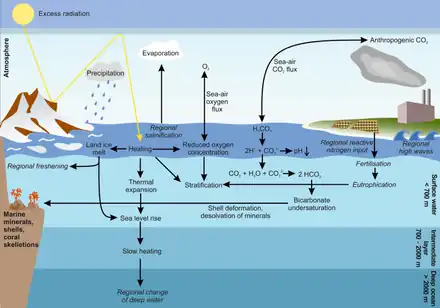
Approaches for reducing CO2 concentrations
Carbon dioxide has unique long-term effects on climate change that are nearly "irreversible" for a thousand years after emissions stop (zero further emissions). The greenhouse gases methane and nitrous oxide do not persist over time in the same way as carbon dioxide. Even if human carbon dioxide emissions were to completely cease, atmospheric temperatures are not expected to decrease significantly in the short term. This is because the air temperature is determined by a balance between heating, due to greenhouse gases, and cooling due to heat transfer to the ocean. If emissions were to stop, CO2 levels and the heating effect would slowly decrease, but simultaneously the cooling due to heat transfer would diminish (because sea temperatures would get closer to the air temperature), with the result that the air temperature would decrease only slowly. Sea temperatures would continue to rise, causing thermal expansion and some sea level rise.[73] Lowering global temperatures more rapidly would require carbon sequestration or geoengineering.
Various techniques have been proposed for removing excess carbon dioxide from the atmosphere.
Concentrations in the geologic past
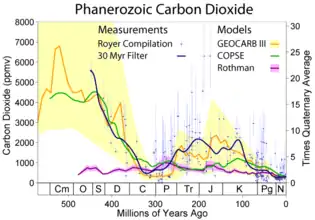
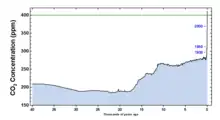
Carbon dioxide is believed to have played an important effect in regulating Earth's temperature throughout its 4.7 billion year history. Early in the Earth's life, scientists have found evidence of liquid water indicating a warm world even though the Sun's output is believed to have only been 70% of what it is today. Higher carbon dioxide concentrations in the early Earth's atmosphere might help explain this faint young sun paradox. When Earth first formed, Earth's atmosphere may have contained more greenhouse gases and CO2 concentrations may have been higher, with estimated partial pressure as large as 1,000 kPa (10 bar), because there was no bacterial photosynthesis to reduce the gas to carbon compounds and oxygen. Methane, a very active greenhouse gas, may have been more prevalent as well.[119][120]
Carbon dioxide concentrations have shown several cycles of variation from about 180 parts per million during the deep glaciations of the Holocene and Pleistocene to 280 parts per million during the interglacial periods. Carbon dioxide concentrations have varied widely over the Earth's 4.54 billion year history. It is believed to have been present in Earth's first atmosphere, shortly after Earth's formation. The second atmosphere, consisting largely of nitrogen and CO
2 was produced by outgassing from volcanism, supplemented by gases produced during the late heavy bombardment of Earth by huge asteroids.[121] A major part of carbon dioxide emissions were soon dissolved in water and incorporated in carbonate sediments.
The production of free oxygen by cyanobacterial photosynthesis eventually led to the oxygen catastrophe that ended Earth's second atmosphere and brought about the Earth's third atmosphere (the modern atmosphere) 2.4 billion years before the present. Carbon dioxide concentrations dropped from 4,000 parts per million during the Cambrian period about 500 million years ago to as low as 180 parts per million during the Quaternary glaciation of the last two million years.[4]
Drivers of ancient-Earth CO2 concentration
On long timescales, atmospheric CO2 concentration is determined by the balance among geochemical processes including organic carbon burial in sediments, silicate rock weathering, and volcanic degassing. The net effect of slight imbalances in the carbon cycle over tens to hundreds of millions of years has been to reduce atmospheric CO2. On a timescale of billions of years, such downward trend appears bound to continue indefinitely as occasional massive historical releases of buried carbon due to volcanism will become less frequent (as earth mantle cooling and progressive exhaustion of internal radioactive heat proceed further). The rates of these processes are extremely slow; hence they are of no relevance to the atmospheric CO2 concentration over the next hundreds or thousands of years.
Photosynthesis in the geologic past
Over the course of Earth's geologic history CO2 concentrations have played a role in biological evolution. The first photosynthetic organisms probably evolved early in the evolutionary history of life and most likely used reducing agents such as hydrogen or hydrogen sulfide as sources of electrons, rather than water.[122] Cyanobacteria appeared later, and the excess oxygen they produced contributed to the oxygen catastrophe,[123] which rendered the evolution of complex life possible. In recent geologic times, low CO2 concentrations below 600 parts per million might have been the stimulus that favored the evolution of C4 plants which increased greatly in abundance between 7 and 5 million years ago over plants that use the less efficient C3 metabolic pathway.[124] At current atmospheric pressures photosynthesis shuts down when atmospheric CO2 concentrations fall below 150 ppm and 200 ppm although some microbes can extract carbon from the air at much lower concentrations.[125][126]
Measuring ancient-Earth CO2 concentration


The most direct method for measuring atmospheric carbon dioxide concentrations for periods before instrumental sampling is to measure bubbles of air (fluid or gas inclusions) trapped in the Antarctic or Greenland ice sheets. The most widely accepted of such studies come from a variety of Antarctic cores and indicate that atmospheric CO2 concentrations were about 260–280 ppmv immediately before industrial emissions began and did not vary much from this level during the preceding 10,000 years.[127] The longest ice core record comes from East Antarctica, where ice has been sampled to an age of 800,000 years.[128] During this time, the atmospheric carbon dioxide concentration has varied between 180 and 210 ppm during ice ages, increasing to 280–300 ppm during warmer interglacials.[129][130] The beginning of human agriculture during the current Holocene epoch may have been strongly connected to the atmospheric CO2 increase after the last ice age ended, a fertilization effect raising plant biomass growth and reducing stomatal conductance requirements for CO2 intake, consequently reducing transpiration water losses and increasing water usage efficiency.[131]
Various proxy measurements have been used to attempt to determine atmospheric carbon dioxide concentrations millions of years in the past. These include boron and carbon isotope ratios in certain types of marine sediments, and the number of stomata observed on fossil plant leaves.[124]
Phytane is a type of diterpenoid alkane. It is a breakdown product of chlorophyll and is now used to estimate ancient CO2 levels.[132] Phytane gives both a continuous record of CO2 concentrations but it also can overlap a break in the CO2 record of over 500 million years.[132]
600 to 400 Ma
There is evidence for high CO2 concentrations of over 3,000 ppm between 200 and 150 million years ago, and of over 6,000 ppm between 600 and 400 million years ago.[25]
60 to 5 Ma
In more recent times, atmospheric CO2 concentration continued to fall after about 60 million years ago. About 34 million years ago, the time of the Eocene–Oligocene extinction event and when the Antarctic ice sheet started to take its current form, CO2 was about 760 ppm,[133] and there is geochemical evidence that concentrations were less than 300 ppm by about 20 million years ago. Decreasing CO2 concentration, with a tipping point of 600 ppm, was the primary agent forcing Antarctic glaciation.[134] Low CO2 concentrations may have been the stimulus that favored the evolution of C4 plants, which increased greatly in abundance between 7 and 5 million years ago.[124]
See also
References
- Showstack, Randy (2013). "Carbon dioxide tops 400 ppm at Mauna Loa, Hawaii". Eos, Transactions American Geophysical Union. 94 (21): 192. Bibcode:2013EOSTr..94Q.192S. doi:10.1002/2013eo210004. ISSN 0096-3941.
- Montaigne, Fen. "Son of Climate Science Pioneer Ponders A Sobering Milestone". Yale Environment 360. Yale School of Forestry & Environmental Studies. Archived from the original on 8 June 2013. Retrieved 14 May 2013.
- "Carbon dioxide now more than 50% higher than pre-industrial levels | National Oceanic and Atmospheric Administration". www.noaa.gov. 3 June 2022. Archived from the original on 5 June 2022. Retrieved 14 June 2022.
- Eggleton, Tony (2013). A Short Introduction to Climate Change. Cambridge University Press. p. 52. ISBN 9781107618763. Archived from the original on 14 March 2023. Retrieved 14 March 2023.
- "The NOAA Annual Greenhouse Gas Index (AGGI) – An Introduction". NOAA Global Monitoring Laboratory/Earth System Research Laboratories. Archived from the original on 27 November 2020. Retrieved 18 December 2020.
- Etheridge, D.M.; L.P. Steele; R.L. Langenfelds; R.J. Francey; J.-M. Barnola; V.I. Morgan (1996). "Natural and anthropogenic changes in atmospheric CO2 over the last 1000 years from air in Antarctic ice and firn". Journal of Geophysical Research. 101 (D2): 4115–28. Bibcode:1996JGR...101.4115E. doi:10.1029/95JD03410. ISSN 0148-0227. S2CID 19674607.
- IPCC (2022) Summary for policy makers Archived 12 March 2023 at the Wayback Machine in Climate Change 2022: Mitigation of Climate Change. Contribution of Working Group III to the Sixth Assessment Report of the Intergovernmental Panel on Climate Change Archived 2 August 2022 at the Wayback Machine, Cambridge University Press, Cambridge, United Kingdom and New York, NY, USA
- Petty, G.W. (2004). "A First Course in Atmospheric Radiation". Eos Transactions. 85 (36): 229–51. Bibcode:2004EOSTr..85..341P. doi:10.1029/2004EO360007.
- Atkins P, de Paula J (2006). Atkins' Physical Chemistry (8th ed.). W. H. Freeman. p. 462. ISBN 978-0-7167-8759-4.
- "Carbon Dioxide Absorbs and Re-emits Infrared Radiation". UCAR Center for Science Education. 2012. Archived from the original on 21 September 2017. Retrieved 9 September 2017.
- Archer D (15 March 2005). "How long will global warming last?". RealClimate. Archived from the original on 4 March 2021. Retrieved 5 March 2021.
- Archer D (2009). "Atmospheric lifetime of fossil fuel carbon dioxide". Annual Review of Earth and Planetary Sciences. 37 (1): 117–34. Bibcode:2009AREPS..37..117A. doi:10.1146/annurev.earth.031208.100206. hdl:2268/12933. Archived from the original on 24 February 2021. Retrieved 7 March 2021.
- Joos F, Roth R, Fuglestvedt JS, Peters GP, Enting IG, Von Bloh W, et al. (2013). "Carbon dioxide and climate impulse response functions for the computation of greenhouse gas metrics: A multi-model analysis". Atmospheric Chemistry and Physics. 13 (5): 2793–2825. doi:10.5194/acpd-12-19799-2012. Archived from the original on 22 July 2020. Retrieved 7 March 2021.
- "Figure 8.SM.4" (PDF). Intergovernmental Panel on Climate Change Fifth Assessment Report. p. 8SM-16. Archived (PDF) from the original on 24 March 2021. Retrieved 7 March 2021.
- Zhang, Yi Ge; et al. (28 October 2013). "A 40-million-year history of atmospheric CO2". Philosophical Transactions of the Royal Society A. 371 (2001): 20130096. Bibcode:2013RSPTA.37130096Z. doi:10.1098/rsta.2013.0096. PMID 24043869.
- "Climate and CO2 in the Atmosphere". Archived from the original on 6 October 2018. Retrieved 10 October 2007.
- Berner RA, Kothavala Z (2001). "GEOCARB III: A revised model of atmospheric CO2 over Phanerozoic Time" (PDF). American Journal of Science. 301 (2): 182–204. Bibcode:2001AmJS..301..182B. CiteSeerX 10.1.1.393.582. doi:10.2475/ajs.301.2.182. Archived (PDF) from the original on 4 September 2011. Retrieved 15 February 2008.
- Friedlingstein, Pierre; O'Sullivan, Michael; Jones, Matthew W.; Andrew, Robbie M.; Gregor, Luke; Hauck, Judith; Le Quéré, Corinne; Luijkx, Ingrid T.; Olsen, Are; Peters, Glen P.; Peters, Wouter; Pongratz, Julia; Schwingshackl, Clemens; Sitch, Stephen; Canadell, Josep G. (11 November 2022). "Global Carbon Budget 2022". Earth System Science Data. 14 (11): 4811–4900. Bibcode:2022ESSD...14.4811F. doi:10.5194/essd-14-4811-2022.
 This article incorporates text from this source, which is available under the CC BY 4.0 license.
This article incorporates text from this source, which is available under the CC BY 4.0 license. - Change, NASA Global Climate. "Carbon Dioxide Concentration | NASA Global Climate Change". Climate Change: Vital Signs of the Planet. Archived from the original on 17 April 2022. Retrieved 17 December 2022.
- "Conversion Tables". Carbon Dioxide Information Analysis Center. Oak Ridge National Laboratory. 18 July 2020. Archived from the original on 27 September 2017. Retrieved 18 July 2020. Alt URL Archived 23 February 2016 at the Wayback Machine
- Eyring, V., N.P. Gillett, K.M. Achuta Rao, R. Barimalala, M. Barreiro Parrillo, N. Bellouin, C. Cassou, P.J. Durack, Y. Kosaka, S. McGregor, S. Min, O. Morgenstern, and Y. Sun, 2021: Chapter 3: Human Influence on the Climate System Archived 7 March 2023 at the Wayback Machine. In Climate Change 2021: The Physical Science Basis. Contribution of Working Group I to the Sixth Assessment Report of the Intergovernmental Panel on Climate Change Archived 9 August 2021 at the Wayback Machine [Masson-Delmotte, V., P. Zhai, A. Pirani, S.L. Connors, C. Péan, S. Berger, N. Caud, Y. Chen, L. Goldfarb, M.I. Gomis, M. Huang, K. Leitzell, E. Lonnoy, J.B.R. Matthews, T.K. Maycock, T. Waterfield, O. Yelekçi, R. Yu, and B. Zhou (eds.)]. Cambridge University Press, Cambridge, United Kingdom and New York, NY, USA, pp. 423–552, doi:10.1017/9781009157896.005.
- Rasmussen, Carl Edward. "Atmospheric Carbon Dioxide Growth Rate". Archived from the original on 14 March 2023. Retrieved 14 March 2023.
- "Frequently Asked Questions". Carbon Dioxide Information Analysis Center (CDIAC). Archived from the original on 17 August 2011. Retrieved 13 June 2007.
- George K, Ziska LH, Bunce JA, Quebedeaux B (2007). "Elevated atmospheric CO2 concentration and temperature across an urban–rural transect". Atmospheric Environment. 41 (35): 7654–7665. Bibcode:2007AtmEn..41.7654G. doi:10.1016/j.atmosenv.2007.08.018. Archived from the original on 15 October 2019. Retrieved 12 September 2019.
- "IPCC: Climate Change 2001: The Scientific Basis" (PDF). Archived (PDF) from the original on 29 August 2022. Retrieved 14 March 2023.
- Tans, Pieter. "Trends in Carbon Dioxide". NOAA/ESRL. Archived from the original on 25 January 2013. Retrieved 11 December 2009.
- "Carbon Budget 2009 Highlights". globalcarbonproject.org. Archived from the original on 16 December 2011. Retrieved 2 November 2012.
- "Carbon dioxide passes symbolic mark". BBC. 10 May 2013. Archived from the original on 23 May 2019. Retrieved 10 May 2013.
- "Up-to-date weekly average CO2 at Mauna Loa". NOAA. Archived from the original on 24 May 2019. Retrieved 1 June 2019.
- "Greenhouse gas levels pass symbolic 400ppm CO2 milestone". The Guardian. Associated Press. 1 June 2012. Archived from the original on 22 January 2014. Retrieved 11 May 2013.
- Kunzig, Robert (9 May 2013). "Climate Milestone: Earth's CO2 Level Passes 400 ppm". National Geographic. Archived from the original on 15 December 2013. Retrieved 12 May 2013.
- "Trends in Atmospheric Carbon Dioxide". Earth System Research Laboratory. NOAA. Archived from the original on 25 January 2013. Retrieved 14 March 2023.
- "The Early Keeling Curve | Scripps CO2 Program". scrippsco2.ucsd.edu. Archived from the original on 8 October 2022. Retrieved 14 March 2023.
- "NOAA CCGG page Retrieved 2 March 2016". Archived from the original on 11 August 2011. Retrieved 14 March 2023.
- WDCGG webpage Archived 6 April 2016 at the Wayback Machine Retrieved 2 March 2016
- RAMCES webpage Retrieved 2 March 2016
- "CDIAC CO2 page Retrieved 9 February 2016". Archived from the original on 13 August 2011. Retrieved 14 March 2023.
- "GLOBALVIEW-CO2 information page. Retrieved 9 February 2016". Archived from the original on 31 January 2020. Retrieved 14 March 2023.
- "TCCON data use policy webpage Retrieved 9 February 2016". Archived from the original on 17 October 2020. Retrieved 14 March 2023.
- e.g. Gosh, Prosenjit; Brand, Willi A. (2003). "Stable isotope ratio mass spectrometry in global climate change research" (PDF). International Journal of Mass Spectrometry. 228 (1): 1–33. Bibcode:2003IJMSp.228....1G. CiteSeerX 10.1.1.173.2083. doi:10.1016/S1387-3806(03)00289-6. Archived (PDF) from the original on 11 August 2017. Retrieved 2 July 2012.
Global change issues have become significant due to the sustained rise in atmospheric trace gas concentrations (CO2, N
2O, CH
4) over recent years, attributable to the increased per capita energy consumption of a growing global population. - Keeling, Charles D.; Piper, Stephen C.; Whorf, Timothy P.; Keeling, Ralph F. (2011). "Evolution of natural and anthropogenic fluxes of atmospheric CO2 from 1957 to 2003". Tellus B. 63 (1): 1–22. Bibcode:2011TellB..63....1K. doi:10.1111/j.1600-0889.2010.00507.x. ISSN 0280-6509.
- Bender, Michael L.; Ho, David T.; Hendricks, Melissa B.; Mika, Robert; Battle, Mark O.; Tans, Pieter P.; Conway, Thomas J.; Sturtevant, Blake; Cassar, Nicolas (2005). "Atmospheric O2/N2changes, 1993–2002: Implications for the partitioning of fossil fuel CO2sequestration". Global Biogeochemical Cycles. 19 (4): n/a. Bibcode:2005GBioC..19.4017B. doi:10.1029/2004GB002410. ISSN 0886-6236.
- Evans, Simon (5 October 2021). "Analysis: Which countries are historically responsible for climate change? / Historical responsibility for climate change is at the heart of debates over climate justice". CarbonBrief.org. Carbon Brief. Archived from the original on 26 October 2021.
Source: Carbon Brief analysis of figures from the Global Carbon Project, CDIAC, Our World in Data, Carbon Monitor, Houghton and Nassikas (2017) and Hansis et al (2015).
- Ballantyne, A.P.; Alden, C.B.; Miller, J.B.; Tans, P.P.; White, J.W.C. (2012). "Increase in observed net carbon dioxide uptake by land and oceans during the past 50 years". Nature. 488 (7409): 70–72. Bibcode:2012Natur.488...70B. doi:10.1038/nature11299. ISSN 0028-0836. PMID 22859203. S2CID 4335259.
- Friedlingstein, P., Jones, M., O'Sullivan, M., Andrew, R., Hauck, J., Peters, G., Peters, W., Pongratz, J., Sitch, S., Le Quéré, C. and 66 others (2019) "Global carbon budget 2019". Earth System Science Data, 11(4): 1783–1838. doi:10.5194/essd-11-1783-2019.
 Material was copied from this source, which is available under a Creative Commons Attribution 4.0 International License.
Material was copied from this source, which is available under a Creative Commons Attribution 4.0 International License. - Dlugokencky, E. (5 February 2016). "Annual Mean Carbon Dioxide Data". Earth System Research Laboratory. NOAA. Archived from the original on 14 March 2023. Retrieved 12 February 2016.
- A.P. Ballantyne; C.B. Alden; J.B. Miller; P.P. Tans; J.W. C. White (2012). "Increase in observed net carbon dioxide uptake by land and oceans during the past 50 years". Nature. 488 (7409): 70–72. Bibcode:2012Natur.488...70B. doi:10.1038/nature11299. PMID 22859203. S2CID 4335259.
- "Global carbon budget 2010 (summary)". Tyndall Centre for Climate Change Research. Archived from the original on 23 July 2012.
- Calculated from file global.1751_2013.csv in Archived 22 October 2011 at the Wayback Machine from the Carbon Dioxide Information Analysis Center.
- IEA (2023), The world’s top 1% of emitters produce over 1000 times more CO2 than the bottom 1%, IEA, Paris https://www.iea.org/commentaries/the-world-s-top-1-of-emitters-produce-over-1000-times-more-co2-than-the-bottom-1 , License: CC BY 4.0
- "Annex II Glossary". Intergovernmental Panel on Climate Change. Archived from the original on 3 November 2018. Retrieved 15 October 2010.
- A concise description of the greenhouse effect is given in the Intergovernmental Panel on Climate Change Fourth Assessment Report, "What is the Greenhouse Effect?" FAQ 1.3 – AR4 WGI Chapter 1: Historical Overview of Climate Change Science Archived 30 November 2018 at the Wayback Machine, IPCC Fourth Assessment Report, Chapter 1, p. 115: "To balance the absorbed incoming [solar] energy, the Earth must, on average, radiate the same amount of energy back to space. Because the Earth is much colder than the Sun, it radiates at much longer wavelengths, primarily in the infrared part of the spectrum (see Figure 1). Much of this thermal radiation emitted by the land and ocean is absorbed by the atmosphere, including clouds, and reradiated back to Earth. This is called the greenhouse effect."
Stephen H. Schneider, in Geosphere-biosphere Interactions and Climate, Lennart O. Bengtsson and Claus U. Hammer, eds., Cambridge University Press, 2001, ISBN 0-521-78238-4, pp. 90–91.
E. Claussen, V.A. Cochran, and D.P. Davis, Climate Change: Science, Strategies, & Solutions, University of Michigan, 2001. p. 373.
A. Allaby and M. Allaby, A Dictionary of Earth Sciences, Oxford University Press, 1999, ISBN 0-19-280079-5, p. 244. - Vaclav Smil (2003). The Earth's Biosphere: Evolution, Dynamics, and Change. MIT Press. p. 107. ISBN 978-0-262-69298-4. Archived from the original on 14 March 2023. Retrieved 14 March 2023.
- "Solar Radiation and the Earth's Energy Balance". The Climate System – EESC 2100 Spring 2007. Columbia University. Archived from the original on 4 November 2004. Retrieved 15 October 2010.
- Le Treut H, Somerville R, Cubasch U, Ding Y, Mauritzen C, Mokssit A, Peterson T, Prather M (2007). "Historical Overview of Climate Change Science" (PDF). In Solomon S, Qin D, Manning M, Chen Z, Marquis M, Averyt KB, Tignor M, Miller HL (eds.). Climate Change 2007: The Physical Science Basis. Contribution of Working Group I to the Fourth Assessment Report of the Intergovernmental Panel on Climate Change. Cambridge, UK and New York, NY: Cambridge University Press. p. 97. Archived from the original (PDF) on 26 November 2018. Retrieved 25 March 2014.
- "The Elusive Absolute Surface Air Temperature (SAT)". Goddard Institute for Space Studies. NOAA. Archived from the original on 5 September 2015. Retrieved 14 March 2023.
- "IPCC Fifth Assessment Report – Chapter 8: Anthropogenic and Natural Radiative Forcing" (PDF). Archived (PDF) from the original on 22 October 2018. Retrieved 14 March 2023.
- Arrhenius, Svante (1896). "On the influence of carbonic acid in the air upon the temperature of the ground" (PDF). Philosophical Magazine and Journal of Science: 237–76. Archived (PDF) from the original on 18 November 2020. Retrieved 14 March 2023.
- Riebeek, Holli (16 June 2011). "The Carbon Cycle". Earth Observatory. NASA. Archived from the original on 5 March 2016. Retrieved 5 April 2018.
- Kayler, Z.; Janowiak, M.; Swanston, C. (2017). "The Global Carbon Cycle". Considering Forest and Grassland Carbon in Land Management (PDF). pp. 3–9. Archived (PDF) from the original on 7 July 2022. Retrieved 14 March 2023.
{{cite book}}:|journal=ignored (help) - Gerlach, T.M. (4 June 1991). "Present-day CO2 emissions from volcanoes". Eos, Transactions, American Geophysical Union. 72 (23): 249, 254–55. Bibcode:1991EOSTr..72..249.. doi:10.1029/90EO10192.
- Cappelluti, G.; Bösch, H.; Monks, P.S. (2009). Use of remote sensing techniques for the detection and monitoring of GHG emissions from the Scottish land use sector. Scottish Government. ISBN 978-0-7559-7738-3. Archived from the original on 8 June 2011. Retrieved 28 January 2011.
- Junling Huang; Michael B. McElroy (2012). "The Contemporary and Historical Budget of Atmospheric CO2" (PDF). Canadian Journal of Physics. 90 (8): 707–16. Bibcode:2012CaJPh..90..707H. doi:10.1139/p2012-033. Archived (PDF) from the original on 3 August 2017. Retrieved 14 March 2023.
- Canadell JG, Le Quéré C, Raupach MR, et al. (November 2007). "Contributions to accelerating atmospheric CO2 growth from economic activity, carbon intensity, and efficiency of natural sinks". Proc. Natl. Acad. Sci. U.S.A. 104 (47): 18866–70. Bibcode:2007PNAS..10418866C. doi:10.1073/pnas.0702737104. PMC 2141868. PMID 17962418.
- Post WM, King AW, Wullschleger SD, Hoffman FM (June 1997). "Historical Variations in Terrestrial Biospheric Carbon Storage". DOE Research Summary. 34 (1): 99–109. Bibcode:1997GBioC..11...99P. doi:10.1029/96GB03942. Archived from the original on 28 July 2011. Retrieved 28 May 2011.
- Nealson KH, Conrad PG (December 1999). "Life: past, present and future". Philos. Trans. R. Soc. Lond. B Biol. Sci. 354 (1392): 1923–39. doi:10.1098/rstb.1999.0532. PMC 1692713. PMID 10670014.
- Whitmarsh J, Govindjee (1999). "The photosynthetic process". In Singhal GS; Renger G; Sopory SK; Irrgang KD; Govindjee (eds.). Concepts in photobiology: photosynthesis and photomorphogenesis. Boston: Kluwer Academic Publishers. pp. 11–51. ISBN 978-0-7923-5519-9. Archived from the original on 14 August 2010. Retrieved 20 March 2014.
100 x 1015 grams of carbon/year fixed by photosynthetic organisms which is equivalent to 4 x 1018 kJ/yr = 4 x 1021J/yr of free energy stored as reduced carbon; (4 x 1018 kJ/yr) / (31,556,900 sec/yr) = 1.27 x 1014 J/yr; (1.27 x 1014 J/yr) / (1012 J/sec / TW) = 127 TW.
- Steger U, Achterberg W, Blok K, Bode H, Frenz W, Gather C, Hanekamp G, Imboden D, Jahnke M, Kost M, Kurz R, Nutzinger HG, Ziesemer T (2005). Sustainable development and innovation in the energy sector. Berlin: Springer. p. 32. ISBN 978-3-540-23103-5. Archived from the original on 14 March 2023. Retrieved 14 March 2023.
The average global rate of photosynthesis is 130 TW (1 TW = 1 terawatt = 1012 watt).
- "World Consumption of Primary Energy by Energy Type and Selected Country Groups, 1980–2004". Energy Information Administration. 31 July 2006. Archived from the original (XLS) on 9 November 2006. Retrieved 2007-01-20.
- Field CB, Behrenfeld MJ, Randerson JT, Falkowski P (July 1998). "Primary production of the biosphere: integrating terrestrial and oceanic components". Science. 281 (5374): 237–40. Bibcode:1998Sci...281..237F. doi:10.1126/science.281.5374.237. PMID 9657713. Archived from the original on 25 September 2018. Retrieved 14 March 2023.
- "Photosynthesis". McGraw-Hill Encyclopedia of Science & Technology. Vol. 13. New York: McGraw-Hill. 2007. ISBN 978-0-07-144143-8.
- Bryant DA, Frigaard NU (November 2006). "Prokaryotic photosynthesis and phototrophy illuminated". Trends Microbiol. 14 (11): 488–96. doi:10.1016/j.tim.2006.09.001. PMID 16997562.
- Susan Solomon; Gian-Kasper Plattner; Reto Knutti; Pierre Friedlingstein (February 2009). "Irreversible climate change due to carbon dioxide emissions". Proc. Natl. Acad. Sci. USA. 106 (6): 1704–09. Bibcode:2009PNAS..106.1704S. doi:10.1073/pnas.0812721106. PMC 2632717. PMID 19179281.
- Archer, David; Eby, Michael; Brovkin, Victor; Ridgwell, Andy; Cao, Long; Mikolajewicz, Uwe; Caldeira, Ken; Matsumoto, Katsumi; Munhoven, Guy; Montenegro, Alvaro; Tokos, Kathy (2009). "Atmospheric Lifetime of Fossil Fuel Carbon Dioxide". Annual Review of Earth and Planetary Sciences. 37 (1): 117–34. Bibcode:2009AREPS..37..117A. doi:10.1146/annurev.earth.031208.100206. hdl:2268/12933. ISSN 0084-6597. Archived from the original on 14 March 2023. Retrieved 14 March 2023.
- Keeling, Charles D. (5 August 1997). "Climate change and carbon dioxide: An introduction". Proceedings of the National Academy of Sciences. 94 (16): 8273–8274. Bibcode:1997PNAS...94.8273K. doi:10.1073/pnas.94.16.8273. ISSN 0027-8424. PMC 33714. PMID 11607732.
- "By 2500 earth could be alien to humans". Scienmag: Latest Science and Health News. 14 October 2021. Archived from the original on 18 October 2021. Retrieved 18 October 2021.
- Lyon, Christopher; Saupe, Erin E.; Smith, Christopher J.; Hill, Daniel J.; Beckerman, Andrew P.; Stringer, Lindsay C.; Marchant, Robert; McKay, James; Burke, Ariane; O’Higgins, Paul; Dunhill, Alexander M.; Allen, Bethany J.; Riel-Salvatore, Julien; Aze, Tracy (2021). "Climate change research and action must look beyond 2100". Global Change Biology. 28 (2): 349–361. doi:10.1111/gcb.15871. ISSN 1365-2486. PMID 34558764. S2CID 237616583.
- IPCC (2021). "Summary for Policymakers" (PDF). The Physical Science Basis. Contribution of Working Group I to the Sixth Assessment Report of the Intergovernmental Panel on Climate Change. ISBN 978-92-9169-158-6.
- "IPCC AR5 Chapter 2 page 193" (PDF). Archived (PDF) from the original on 21 November 2016. Retrieved 28 January 2016.
- Houghton, ed. (2001). "Climate Change 2001: Working Group I: The Scientific Basis – Chapter 12: Detection of Climate Change and Attribution of Causes". IPCC. Archived from the original on 11 July 2007. Retrieved 13 July 2007.
- "Ch 6. Changes in the Climate System". Advancing the Science of Climate Change. 2010. doi:10.17226/12782. ISBN 978-0-309-14588-6.
- Swanson, K.L.; Sugihara, G.; Tsonis, A.A. (22 September 2009). "Long-term natural variability and 20th century climate change". Proc. Natl. Acad. Sci. U.S.A. 106 (38): 16120–3. Bibcode:2009PNAS..10616120S. doi:10.1073/pnas.0908699106. PMC 2752544. PMID 19805268.
- "Summary for Policymakers". The Ocean and Cryosphere in a Changing Climate (PDF). 2019. pp. 3–36. doi:10.1017/9781009157964.001. ISBN 978-1-00-915796-4. Archived (PDF) from the original on 29 March 2023. Retrieved 26 March 2023.
- Cheng, Lijing; Abraham, John; Trenberth, Kevin E.; Fasullo, John; Boyer, Tim; Mann, Michael E.; Zhu, Jiang; Wang, Fan; Locarnini, Ricardo; Li, Yuanlong; Zhang, Bin; Yu, Fujiang; Wan, Liying; Chen, Xingrong; Feng, Licheng (2023). "Another Year of Record Heat for the Oceans". Advances in Atmospheric Sciences. 40 (6): 963–974. doi:10.1007/s00376-023-2385-2. ISSN 0256-1530. PMC 9832248. PMID 36643611. Text was copied from this source, which is available under a Creative Commons Attribution 4.0 International License
- Fox-Kemper, B., H.T. Hewitt, C. Xiao, G. Aðalgeirsdóttir, S.S. Drijfhout, T.L. Edwards, N.R. Golledge, M. Hemer, R.E. Kopp, G. Krinner, A. Mix, D. Notz, S. Nowicki, I.S. Nurhati, L. Ruiz, J.-B. Sallée, A.B.A. Slangen, and Y. Yu, 2021: Chapter 9: Ocean, Cryosphere and Sea Level Change Archived 2022-10-24 at the Wayback Machine. In Climate Change 2021: The Physical Science Basis. Contribution of Working Group I to the Sixth Assessment Report of the Intergovernmental Panel on Climate Change Archived 2021-08-09 at the Wayback Machine [Masson-Delmotte, V., P. Zhai, A. Pirani, S.L. Connors, C. Péan, S. Berger, N. Caud, Y. Chen, L. Goldfarb, M.I. Gomis, M. Huang, K. Leitzell, E. Lonnoy, J.B.R. Matthews, T.K. Maycock, T. Waterfield, O. Yelekçi, R. Yu, and B. Zhou (eds.)]. Cambridge University Press, Cambridge, United Kingdom and New York, NY, USA, pp. 1211–1362
- Gille, Sarah T. (15 February 2002). "Warming of the Southern Ocean Since the 1950s". Science. 295 (5558): 1275–1277. Bibcode:2002Sci...295.1275G. doi:10.1126/science.1065863. PMID 11847337. S2CID 31434936.
- Terhaar, Jens; Frölicher, Thomas L.; Joos, Fortunat (2023). "Ocean acidification in emission-driven temperature stabilization scenarios: the role of TCRE and non-CO2 greenhouse gases". Environmental Research Letters. 18 (2): 024033. Bibcode:2023ERL....18b4033T. doi:10.1088/1748-9326/acaf91. ISSN 1748-9326. S2CID 255431338.
Figure 1f
- Ocean acidification due to increasing atmospheric carbon dioxide (PDF). Royal Society. 2005. ISBN 0-85403-617-2.
- Jiang, Li-Qing; Carter, Brendan R.; Feely, Richard A.; Lauvset, Siv K.; Olsen, Are (2019). "Surface ocean pH and buffer capacity: past, present and future". Scientific Reports. 9 (1): 18624. Bibcode:2019NatSR...918624J. doi:10.1038/s41598-019-55039-4. PMC 6901524. PMID 31819102.
 Text was copied from this source, which is available under a Creative Commons Attribution 4.0 International License Archived 16 October 2017 at the Wayback Machine
Text was copied from this source, which is available under a Creative Commons Attribution 4.0 International License Archived 16 October 2017 at the Wayback Machine - Zhang, Y.; Yamamoto‐Kawai, M.; Williams, W.J. (16 February 2020). "Two Decades of Ocean Acidification in the Surface Waters of the Beaufort Gyre, Arctic Ocean: Effects of Sea Ice Melt and Retreat From 1997–2016". Geophysical Research Letters. 47 (3). doi:10.1029/2019GL086421. S2CID 214271838.
- Beaupré-Laperrière, Alexis; Mucci, Alfonso; Thomas, Helmuth (31 July 2020). "The recent state and variability of the carbonate system of the Canadian Arctic Archipelago and adjacent basins in the context of ocean acidification". Biogeosciences. 17 (14): 3923–3942. Bibcode:2020BGeo...17.3923B. doi:10.5194/bg-17-3923-2020. S2CID 221369828.
- Ueyama M, Ichii K, Kobayashi H, Kumagai TO, Beringer J, Merbold L, et al. (17 July 2020). "Inferring CO2 fertilization effect based on global monitoring land-atmosphere exchange with a theoretical model". Environmental Research Letters. 15 (8): 084009. Bibcode:2020ERL....15h4009U. doi:10.1088/1748-9326/ab79e5. ISSN 1748-9326.
- Tharammal T, Bala G, Narayanappa D, Nemani R (April 2019). "Potential roles of CO2 fertilization, nitrogen deposition, climate change, and land use and land cover change on the global terrestrial carbon uptake in the twenty-first century". Climate Dynamics. 52 (7–8): 4393–4406. Bibcode:2019ClDy...52.4393T. doi:10.1007/s00382-018-4388-8. ISSN 0930-7575. S2CID 134286531.
- Hararuk O, Campbell EM, Antos JA, Parish R (December 2018). "Tree rings provide no evidence of a CO2 fertilization effect in old-growth subalpine forests of western Canada". Global Change Biology. 25 (4): 1222–1234. Bibcode:2019GCBio..25.1222H. doi:10.1111/gcb.14561. PMID 30588740.
- Cartwright J (16 August 2013). "How does carbon fertilization affect crop yield?". environmentalresearchweb. Environmental Research Letters. Archived from the original on 27 June 2018. Retrieved 3 October 2016.
- Smith WK, Reed SC, Cleveland CC, Ballantyne AP, Anderegg WR, Wieder WR, et al. (March 2016). "Large divergence of satellite and Earth system model estimates of global terrestrial CO2 fertilization". Nature Climate Change. 6 (3): 306–310. Bibcode:2016NatCC...6..306K. doi:10.1038/nclimate2879. ISSN 1758-678X.
- Chen C, Riley WJ, Prentice IC, Keenan TF (March 2022). "CO2 fertilization of terrestrial photosynthesis inferred from site to global scales". Proceedings of the National Academy of Sciences of the United States of America. 119 (10): e2115627119. doi:10.1073/pnas.2115627119. PMC 8915860. PMID 35238668.
- Bastos A, Ciais P, Chevallier F, Rödenbeck C, Ballantyne AP, Maignan F, Yin Y, Fernández-Martínez M, Friedlingstein P, Peñuelas J, Piao SL (7 October 2019). "Contrasting effects of CO2 fertilization, land-use change and warming on seasonal amplitude of Northern Hemisphere CO2 exchange". Atmospheric Chemistry and Physics. 19 (19): 12361–12375. Bibcode:2019ACP....1912361B. doi:10.5194/acp-19-12361-2019. ISSN 1680-7324.
- Li Q, Lu X, Wang Y, Huang X, Cox PM, Luo Y (November 2018). "Leaf Area Index identified as a major source of variability in modelled CO2 fertilization". Biogeosciences. 15 (22): 6909–6925. doi:10.5194/bg-2018-213.
- Albani M, Medvigy D, Hurtt GC, Moorcroft PR (December 2006). "The contributions of land-use change, CO2 fertilization, and climate variability to the Eastern US carbon sink: Partitioning of the Eastern US Carbon Sink". Global Change Biology. 12 (12): 2370–2390. doi:10.1111/j.1365-2486.2006.01254.x. S2CID 2861520.
- Wang S, Zhang Y, Ju W, Chen JM, Ciais P, Cescatti A, et al. (December 2020). "Recent global decline of CO2 fertilization effects on vegetation photosynthesis". Science. 370 (6522): 1295–1300. Bibcode:2020Sci...370.1295W. doi:10.1126/science.abb7772. hdl:10067/1754050151162165141. PMID 33303610. S2CID 228084631.
- Sugden AM (11 December 2020). Funk M (ed.). "A decline in the carbon fertilization effect". Science. 370 (6522): 1286.5–1287. Bibcode:2020Sci...370S1286S. doi:10.1126/science.370.6522.1286-e. S2CID 230526366.
- Kirschbaum MU (January 2011). "Does enhanced photosynthesis enhance growth? Lessons learned from CO2 enrichment studies". Plant Physiology. 155 (1): 117–24. doi:10.1104/pp.110.166819. PMC 3075783. PMID 21088226.
- "Global Green Up Slows Warming". earthobservatory.nasa.gov. 18 February 2020. Retrieved 27 December 2020.
- Tabor A (8 February 2019). "Human Activity in China and India Dominates the Greening of Earth". NASA. Retrieved 27 December 2020.
- Zhu Z, Piao S, Myneni RB, Huang M, Zeng Z, Canadell JG, et al. (1 August 2016). "Greening of the Earth and its drivers". Nature Climate Change. 6 (8): 791–795. Bibcode:2016NatCC...6..791Z. doi:10.1038/nclimate3004. S2CID 7980894.
- Hille K (25 April 2016). "Carbon Dioxide Fertilization Greening Earth, Study Finds". NASA. Retrieved 27 December 2020.
- "If you're looking for good news about climate change, this is about the best there is right now". Washington Post. Retrieved 11 November 2016.
- Schimel D, Stephens BB, Fisher JB (January 2015). "Effect of increasing CO2 on the terrestrial carbon cycle". Proceedings of the National Academy of Sciences of the United States of America. 112 (2): 436–41. Bibcode:2015PNAS..112..436S. doi:10.1073/pnas.1407302112. PMC 4299228. PMID 25548156.
- Pisoft, Petr (25 May 2021). "Stratospheric contraction caused by increasing greenhouse gases". Environmental Research Letters. 16 (6): 064038. Bibcode:2021ERL....16f4038P. doi:10.1088/1748-9326/abfe2b.
- "Effects of climate change". Met Office. Retrieved 23 April 2023.
- Käse, Laura; Geuer, Jana K. (2018). "Phytoplankton Responses to Marine Climate Change – an Introduction". YOUMARES 8 – Oceans Across Boundaries: Learning from each other. pp. 55–71. doi:10.1007/978-3-319-93284-2_5. ISBN 978-3-319-93283-5. S2CID 134263396.
- Cheng, Lijing; Abraham, John; Hausfather, Zeke; Trenberth, Kevin E. (11 January 2019). "How fast are the oceans warming?". Science. 363 (6423): 128–129. Bibcode:2019Sci...363..128C. doi:10.1126/science.aav7619. PMID 30630919. S2CID 57825894.
- Doney, Scott C.; Busch, D. Shallin; Cooley, Sarah R.; Kroeker, Kristy J. (17 October 2020). "The Impacts of Ocean Acidification on Marine Ecosystems and Reliant Human Communities". Annual Review of Environment and Resources. 45 (1): 83–112. doi:10.1146/annurev-environ-012320-083019.
 Text was copied from this source, which is available under a Creative Commons Attribution 4.0 International License Archived 2017-10-16 at the Wayback Machine
Text was copied from this source, which is available under a Creative Commons Attribution 4.0 International License Archived 2017-10-16 at the Wayback Machine - IPCC, 2021: Annex VII: Glossary [Matthews, J.B.R., V. Möller, R. van Diemen, J.S. Fuglestvedt, V. Masson-Delmotte, C. Méndez, S. Semenov, A. Reisinger (eds.)]. In Climate Change 2021: The Physical Science Basis. Contribution of Working Group I to the Sixth Assessment Report of the Intergovernmental Panel on Climate Change [Masson-Delmotte, V., P. Zhai, A. Pirani, S.L. Connors, C. Péan, S. Berger, N. Caud, Y. Chen, L. Goldfarb, M.I. Gomis, M. Huang, K. Leitzell, E. Lonnoy, J.B.R. Matthews, T.K. Maycock, T. Waterfield, O. Yelekçi, R. Yu, and B. Zhou (eds.)]. Cambridge University Press, Cambridge, United Kingdom and New York, NY, USA, pp. 2215–2256, doi:10.1017/9781009157896.022.
- Geden, Oliver (May 2016). "An actionable climate target". Nature Geoscience. 9 (5): 340–342. Bibcode:2016NatGe...9..340G. doi:10.1038/ngeo2699. ISSN 1752-0908. Archived from the original on 25 May 2021. Retrieved 7 March 2021.
- Schenuit, Felix; Colvin, Rebecca; Fridahl, Mathias; McMullin, Barry; Reisinger, Andy; Sanchez, Daniel L.; Smith, Stephen M.; Torvanger, Asbjørn; Wreford, Anita; Geden, Oliver (4 March 2021). "Carbon Dioxide Removal Policy in the Making: Assessing Developments in 9 OECD Cases". Frontiers in Climate. 3: 638805. doi:10.3389/fclim.2021.638805. ISSN 2624-9553.
- IPCC (2022). Shukla, P.R.; Skea, J.; Slade, R.; Al Khourdajie, A.; et al. (eds.). Climate Change 2022: Mitigation of Climate Change (PDF). Contribution of Working Group III to the Sixth Assessment Report of the Intergovernmental Panel on Climate Change. Cambridge, UK and New York, NY, USA: Cambridge University Press (In Press). doi:10.1017/9781009157926. ISBN 9781009157926.
- Walker, James C.G. (June 1985). "Carbon dioxide on the early earth" (PDF). Origins of Life and Evolution of the Biosphere. 16 (2): 117–27. Bibcode:1985OrLi...16..117W. doi:10.1007/BF01809466. hdl:2027.42/43349. PMID 11542014. S2CID 206804461. Archived (PDF) from the original on 14 September 2012. Retrieved 30 January 2010.
- Pavlov, Alexander A.; Kasting, James F.; Brown, Lisa L.; Rages, Kathy A.; Freedman, Richard (May 2000). "Greenhouse warming by CH4 in the atmosphere of early Earth". Journal of Geophysical Research. 105 (E5): 11981–90. Bibcode:2000JGR...10511981P. doi:10.1029/1999JE001134. PMID 11543544.
- Zahnle, K.; Schaefer, L.; Fegley, B. (2010). "Earth's Earliest Atmospheres". Cold Spring Harbor Perspectives in Biology. 2 (10): a004895. doi:10.1101/cshperspect.a004895. PMC 2944365. PMID 20573713.
- Olson JM (May 2006). "Photosynthesis in the Archean era". Photosynth. Res. 88 (2): 109–17. doi:10.1007/s11120-006-9040-5. PMID 16453059. S2CID 20364747.
- Buick R (August 2008). "When did oxygenic photosynthesis evolve?". Philos. Trans. R. Soc. Lond. B Biol. Sci. 363 (1504): 2731–43. doi:10.1098/rstb.2008.0041. PMC 2606769. PMID 18468984.
- Osborne, C.P.; Beerling, D.J. (2006). "Nature's green revolution: the remarkable evolutionary rise of C4 plants". Philosophical Transactions of the Royal Society B: Biological Sciences. 361 (1465): 173–94. doi:10.1098/rstb.2005.1737. PMC 1626541. PMID 16553316.
- Lovelock, J. E. (1972). "Gaia as seen through the atmosphere". Atmospheric Environment. 6 (8): 579–580. Bibcode:1972AtmEn...6..579L. doi:10.1016/0004-6981(72)90076-5. Archived from the original on 3 November 2011. Retrieved 22 March 2014.
- Li, K.-F. (30 May 2009). "Atmospheric pressure as a natural climate regulator for a terrestrial planet with a biosphere". Proceedings of the National Academy of Sciences. 106 (24): 9576–9579. Bibcode:2009PNAS..106.9576L. doi:10.1073/pnas.0809436106. PMC 2701016. PMID 19487662. Archived from the original on 12 February 2013. Retrieved 22 March 2014.
- Etheridge, D.M.; Steele, L.P.; Langenfelds, R.L.; Francey, R.J.; Barnola, JM; Morgan, VI (June 1998). "Historical CO2 record derived from a spline fit (20-year cutoff) of the Law Dome DE08 and DE08-2 ice cores". Carbon Dioxide Information Analysis Center. Oak Ridge National Laboratory. Archived from the original on 5 March 2012. Retrieved 12 June 2007.
- Amos, J. (4 September 2006). "Deep ice tells long climate story". BBC News. Archived from the original on 23 January 2013. Retrieved 28 April 2010.
- Hileman B. (November 2005). "Ice Core Record Extended: Analyses of trapped air show current CO2 at highest level in 650,000 years". Chemical & Engineering News. 83 (48): 7. doi:10.1021/cen-v083n048.p007. ISSN 0009-2347. Archived from the original on 15 May 2019. Retrieved 28 January 2010.
- Vostok Ice Core Data Archived 27 February 2015 at the Wayback Machine, ncdc.noaa.gov Archived 22 April 2021 at the Wayback Machine
- Richerson P.J.; Boyd R.; Bettinger R.L. (July 2001). "Was Agriculture Impossible During The Pleistocene But Mandatory During The Holocene?" (PDF). American Antiquity. 66 (3): 387–411. doi:10.2307/2694241. JSTOR 2694241. S2CID 163474968. Archived from the original (PDF) on 12 January 2006.
- Witkowski, Caitlyn (28 November 2018). "Molecular fossils from phytoplankton reveal secular pCO2 trend over the Phanerozoic". Science Advances. 2 (11): eaat4556. Bibcode:2018SciA....4.4556W. doi:10.1126/sciadv.aat4556. PMC 6261654. PMID 30498776.
- "New CO2 data helps unlock the secrets of Antarctic formation". Physorg.com. 13 September 2009. Archived from the original on 15 July 2011. Retrieved 28 January 2010.
- Pagani, Mark; Huber, Matthew; Liu, Zhonghui; Bohaty, Steven M.; Henderiks, Jorijntje; Sijp, Willem; Krishnan, Srinath; Deconto, Robert M. (2 December 2011). "Drop in carbon dioxide levels led to polar ice sheet, study finds". Science. 334 (6060): 1261–4. Bibcode:2011Sci...334.1261P. doi:10.1126/science.1203909. PMID 22144622. S2CID 206533232. Archived from the original on 22 May 2013. Retrieved 14 May 2013.
External links
- Current global map of carbon dioxide concentrations.
- Global Carbon Dioxide Circulation (NASA; 13 December 2016)
- Video (03:10) – A Year in the Life of Earth's CO2 (NASA; 17 November 2014)

